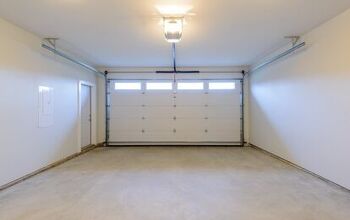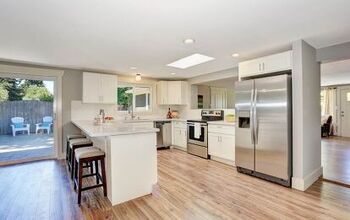Lights Dim When AC Turns On? (Possible Causes & Fixes)

There is no mistaking when the AC comes on in your house. Not only can you hear the condensing unit start, the lights in the house flicker, dimming for a few moments each time. What does it mean with the lights dim each time the AC turns on?
Lights often dim by 3%-5% when the AC turns on, but losing more light can indicate a bad capacitor. Replace the capacitor or inspect the AC unit for damaged and loose wires. Hire an HVAC professional to inspect and rewire your air conditioner if the wires have poor connections.
A significant loss of brightness in your lights when the AC unit starts indicates symptoms related to several problems. Don’t ignore these symptoms if you want to avoid bigger problems. You can check for some of these problems. Other problems that can cause dim lights when the AC starts requiring the attention of trained service technicians.
Do You Need to Hire an Electrician?
Get free, zero-commitment quotes from pro contractors near you.

An Overview of Your AC Condensing Unit
The heart of your AC system is the condensing unit. The condensing unit is responsible for pumping the refrigerant fluid from the compressor to the coil in your home. The refrigerant is allowed to expand, absorbing heat from the air as it passes over the coils.
The electric motor that powers the pump in the condensing unit requires extra power each time it starts. The condensing unit has a capacitor which stores that extra power to give the motor that extra boost.
Several problems in the AC condensing unit can lead to a motor overdrawing power from the electrical system. This extra demand results in the lights losing much more brightness than normal. These problems can ultimately lead to the failure of the whole condensing unit or a failure in the electrical system.
Why Do My Lights Dim When My AC Comes On?
While your lights dimming each time your air conditioner starts up may be an annoyance, it’s generally not a cause for concern. Your air conditioning systems needs a lot of electricity to power up. So, when it turns on, it’s normal for the electricity to temporarily get drained from other appliances in your home, such as your light bulbs.
So, this is why it’s very common for your light bulbs to briefly lose brightness when your AC starts up. This is typically a normal occurrence if:
- Your lights only dim for a brief second.
- Your lights only lose about 5% of their normal brightness.
However, if the loss of brightness is more significant, something as simple as dimming lights may be an indication of a larger issue. With that said, the following are some of the common reasons why your lights are dimming when your air conditioner starts:
1. A Bad Capacitor
The capacitor installed on the AC condensing unit stores extra energy that the motor can use to go from a standstill to full power in seconds. It essentially acts as a battery, giving your compressor motor the necessary burst of power to turn on. Without a capacitor, the electrical circuits serving your AC would need to be much heavier with larger wires and higher amperage service.
Capacitors fail over time and lose their ability to store energy. As the capacitor begins to fail, it cannot store enough energy to provide what the motor needs to start. Higher energy needs cause the motor to pull more energy from your home electrical system. The result is a deeper dimming of the lights. When this happens, the AC will have to drain more voltage from other appliances in your home – thus causing your lights to temporarily dim.
Eventually, the capacitor will fail and will need replacement. If you notice the lights in your home getting dimmer each time the AC unit starts, you should suspect that the capacitor is beginning to fail.
Turn to the Service Technician
While the capacitor’s actual replacement is relatively easy, a trained HVAC service rep is the best alternative. Each model of AC unit requires a specific capacitor matched with the motor. Using the wrong capacitor can damage or destroy the motor in your AC unit. This requires a much more expensive repair.
Also, the capacitor is a high energy device that can store significant electrical current for long periods. Without understanding how to properly and safely unhook and reinstall a high-energy capacitor, you risk serious injury.
2. Providing the Power to the AC Unit
Getting enough power to the AC unit may also have its problems. The condensing unit on your AC system is probably the most electrical hungry appliance in your home. When the condensing unit starts, it draws more amps than any other appliance, even an electric cook stove.
This high amperage draw means that any deficiency in the electrical wiring or circuits can hamper enough energy delivery. This demand can cause the lights to dim significantly in your home when the AC unit starts. Several factors can underlie the inability of the AC to get sufficient energy to start.
Damaged or Loose Wires
While it is uncommon for the electrical wires in your home to become loose or damaged, the possibility still exists. The age of your home and the type of wiring used in your home can be contributing factors
Some older homes have electrical wiring covered with fabric insulation. Rodents can attack this type of wiring with detrimental effects. A trained electrician can check the wiring and ensure no such damage in the system that would cause your lights to dim.
Bad Connections
Your AC unit lives outside your house and must exist in the most extreme weather your climate can produce. These conditions range from hard freezing weather or extremely high humidity. Some of these environmental conditions can cause problems with electrical connections.
The problems may be with connections at exterior fuse boxes or main cut-off switches or in the AC unit. A trained HVAC technician can check these connections and repair any problems that might become apparent.
3. Insufficient Wiring
Wiring that is unable to deliver enough amperage to the AC unit when it starts occurs most often seen with the installation of new, more powerful AC units. Many new AC condensing units are more energy efficient but draw more power on start-up than older units.
The wiring in older homes may lack the capacity to deliver this higher amperage load at system startup. The result is the excessive dimming of lights throughout the house. The dimming effect can cause other appliances problems when they experience less than the required amperage to operate.
If the older wiring in your home is the problem, the only long-range solution is to run new wiring from the AC unit’s service panel. You should hire a qualified and licensed electrician for this job. Your electrician can determine the proper size wire to serve your AC unit adequately and install the wire to meet local codes.
4. Overloaded Service Panel
The electrical service to your home has an amperage rating, and the service panel matches that rating. In most homes, the electrical service provided by the power utility is 100 amps. Your service panel is, more than likely, a 100 amp panel.
Suppose you have added on to your home or have unusually large energy demands in your home. In that case, you may be nearing the maximum capability of the electrical service or the service panel.
Determining if you are near or exceed the maximum service for your electrical system requires a demand audit. In many cities and towns, your electrical utility provider offers this service free of charge.
A demand audit is simply a survey of all the electrical needs of your home. From this survey, an estimation of your electrical usage is made based on the appliances frequently used. The electrical utility representative can then make recommendations on how to lower your electrical demands or increase the available electrical service to your home.
5. Shared Electrical Service
Most new homes have a dedicated electrical circuit and circuit breakers that serve only the AC condensing unit. However, in some older homes, especially those with AC added later, the AC unit may have other appliances in the circuit.
If you know that your home electrical system shares the AC circuit with other appliances, you should unplug those other appliances. Removing other appliances will lessen the load on the circuit, giving the AC unit more power when starting. Fewer draws on the circuit should help with the dimming lights in the short term.
Long-term, it is best to contact a licensed electrician to have a new dedicated circuit installed to serve the AC unit. A new circuit will ensure that the AC condensing unit has all the power it needs. Your other appliances can then operate normally as well.
Can I Do Any of These Repairs or Upgrades Myself?
Probably. Many homeowners are more than qualified to make repairs and upgrades to their home electrical system. Changing a capacitor in an AC unit is relatively easy. Should you decide to make these upgrades or repairs, you should remember a few things.
- Electricity is dangerous. Always work safely. Turn off the circuit breakers to any wiring on which you are working. Never work on a live circuit.
- Check with your Local Building Inspector. Many cities and towns require the inspection of any electrical work before returning the system to service. Get your permits before you start.
- Use the right parts for repairs. Using the correct part is especially true for capacitors on AC units. The capacitor must be the exact replacement part of your AC unit. Trying to make something else work can be dangerous. At best, it will cause other problems with your AC unit. At worst, it can fail and cause a fire or other catastrophic damage.
Do You Need to Hire an Electrician?
Get free, zero-commitment quotes from pro contractors near you.

When the Lights Dim, Don’t Panic
A short dimming of lights when your AC unit starts is entirely normal. You should only worry if the dimming lasts more than a few seconds or the lights lose more than 50 percent of their brightness.
We hope that this article has eased some of your fears about the lights dimming when your AC unit starts. If you suspect that you have a problem, contact a trained HVAC service technician or an electrician to help you diagnose and correct the problem.
Related Questions
How much does it cost to replace an AC capacitor?
The average cost to replace an AC capacitor is $170, though you could pay as much as $400 depending on the brand, model, whether it’s single or dual-run, and the local labor costs for installation.
Can low voltage damage AC?
Just like any other appliance, your AC unit is prone to power surges. When the voltage gets too low, the motor must pull in more current than normal, causing the temperature of the motor windings to increase by 10 to 15 percent for each 10 percent decrease in voltage. This can cause damage to the motors and wear on the overall lifespan of your AC.For this reason, it’s recommended that homeowners purchase some sort of surge and low-voltage protector for their AC unit.

Dennis is a retired firefighter with an extensive background in construction, home improvement, and remodeling. He worked in the trades part-time while serving as an active firefighter. On his retirement, he started a remodeling and home repair business, which he ran for several years.
More by Dennis Howard













![10 Best Electric Lawn Mowers - [2022 Reviews & Top Rated Models]](https://cdn-fastly.upgradedhome.com/media/2023/07/31/9070486/10-best-electric-lawn-mowers-2022-reviews-top-rated-models.jpg?size=350x220)
![Finishing Basement Without Permit [Is It Really Illegal?]](https://cdn-fastly.upgradedhome.com/media/2023/07/31/9070078/finishing-basement-without-permit-is-it-really-illegal.jpg?size=350x220)












